MXA RACE TEST: THE REAL TEST OF THE 2025 KTM 250SXF
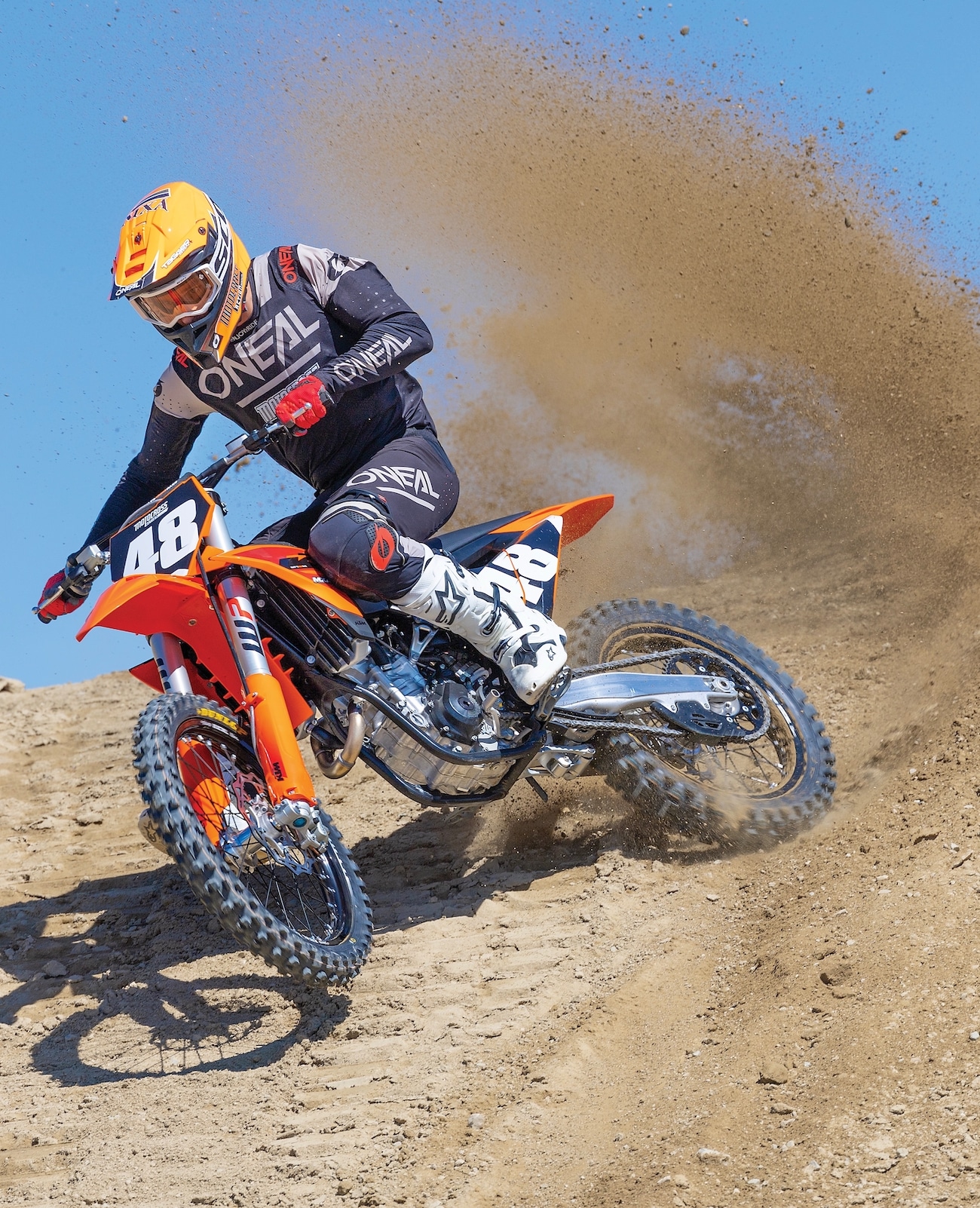
Q: FIRST AND FOREMOST, IS THE 2025 KTM 250SXF BETTER THAN THE 2024 KTM 250SXF?
A: Yes! The KTM 250SXF was all new in 2023, and it has won the “MXA 250 Shootout” the last two seasons, but it wasn’t a perfect bike. The frame was on the stiff side in 2023 and 2024—and it took a while to break in. Sure, most of our KTM frame complaints were aimed at the 450SXF, but the updates on the 2025 KTM models offer a lot of benefits on the 250SXF as well. The frame, linkage and swingarm all keep the same geometry as before, but materials have been removed to create a softer feel on the track. Additionally, the suspension settings have been updated to work with the new chassis and the shock gained new low-stiction seals.
Cosmetically, the radiator shrouds are slightly different on the bottom to keep your boot from snagging on the lower corner. Keep this in mind when ordering new graphics. We’ve ordered radiator graphics for our 2025 test bikes only to have them send us stickers for a 2024 model; they don’t fit the same.
 Kind of like Goldilocks’ porridge, the KTM footpegs aren’t too sharp, aren’t too narrow and are neatly tucked in as close as possible to the frame.
Kind of like Goldilocks’ porridge, the KTM footpegs aren’t too sharp, aren’t too narrow and are neatly tucked in as close as possible to the frame.
Q: WHAT’S NEW ON THE 2025 KTM 250SXF FRAME?
A: There are only two chassis updates that are visible to the untrained eye. New for 2025, the forged shock tower has two large relief holes (one on either side) milled in to improve chassis flex. This is something that was seen on the prototype MXGP frames in 2023 and 2024, and made its production debut on the 2024-1/2 KTM, Husqvarna and GasGas Factory Editions. The head stays are also relieved on the new chassis to improve flex as well. The shock tower holes and the hollow head stays aren’t the only updates to the chassis, but they do get most of the credit, as the other changes are more difficult to see.
In 2023, the goal of the then-new frame centered around getting increased stability and balance out of the chassis, but with those changes came added rigidity, which resulted in a much harsher ride. The thick forged-steel backbone plates that were welded to the top of the frame’s backbone and wrapped around the head tube were made thinner for the 2025 frame to allow for more flex. Plus, the two, long, symmetrical, curved frame tubes, which are the main tubes visible from either side of the bike, were made with thinner wall tubing for the 2025 models.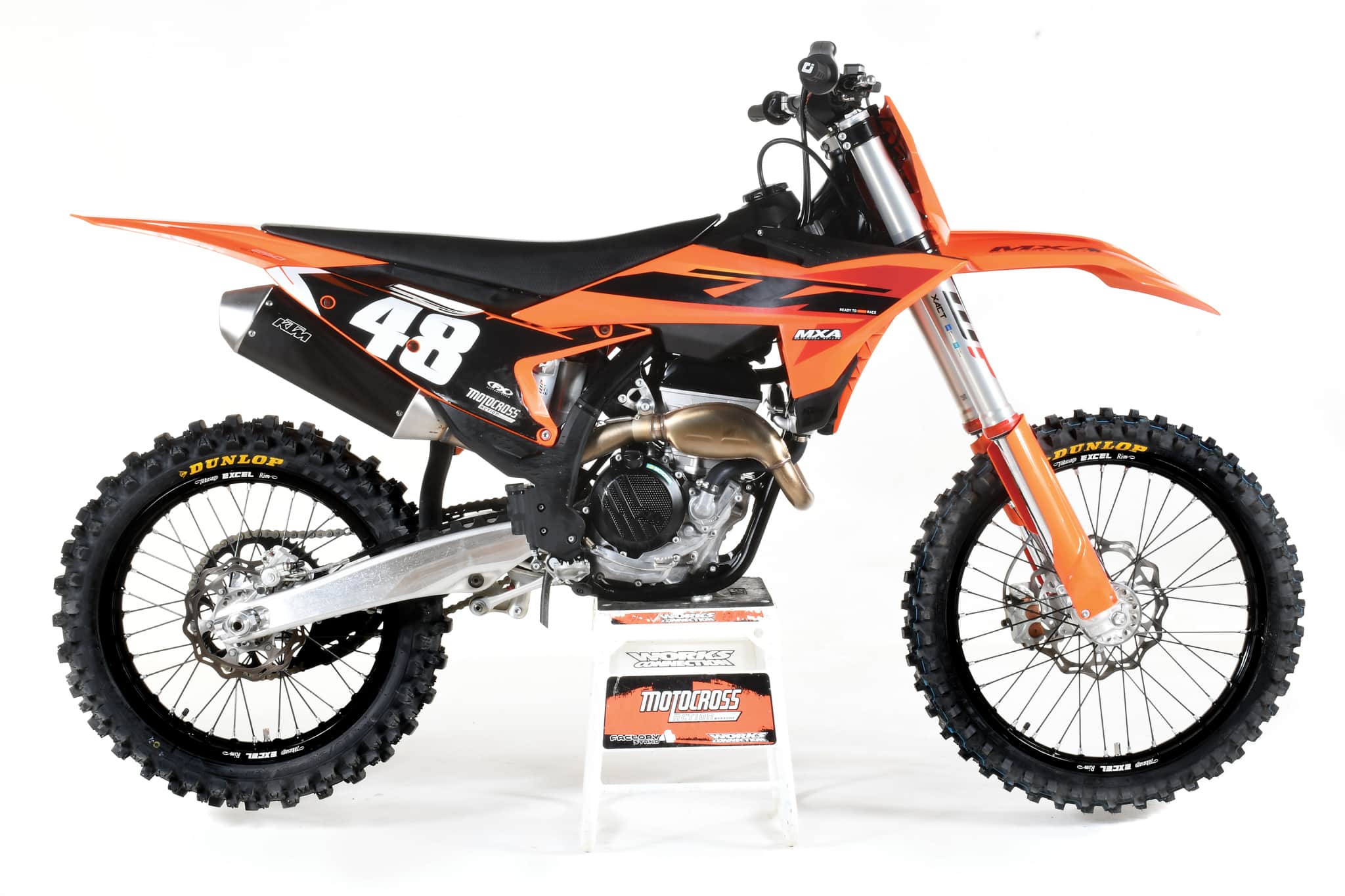 The overall design for the 2025 KTM model line is straightforward, less busy and cleaner. Everything is either black or orange.
The overall design for the 2025 KTM model line is straightforward, less busy and cleaner. Everything is either black or orange.
Q: WHAT’S NEW ON THE SWINGARM?
A: In 2023, KTM rotated their engine backward by 2 degrees to lower the countershaft sprocket. What did that achieve? It lessened rear-end squat under acceleration by reducing chain torque. The pioneers of anti-chain torque systems were ATK’s Horst Leitner and Boyesen Engineering’s Eyvind Boyesen. Their testing and engineering proved that rear-end squat (the tendency of the rear suspension to drop under acceleration) was a byproduct of the bike’s chain line, as determined by the angle the chain follows from the rear sprocket to the countershaft sprocket. Changing the chain line, by either raising the swingarm pivot on the frame or lowering the countershaft sprocket on the engine, greatly reduces squat. The KTM R&D test riders felt that squat exhibited its worst traits in consecutive whoops, which made it most noticeable on a Supercross track for pro riders and in acceleration bumps coming out of a rutted corner for local racers.
On the 2023-and-newer models, the lowered countershaft sprocket position did reduce squatting and help with chassis balance front to rear, but it also required a lot more chain slack. KTM recommends 70mm of slack, which is approximately four fingers under the top run of the chain at the rear of the buffer pad.
New for 2025, the swingarm and buffer pad have both been massaged to stop the chain from eating through the buffer pad where the chain goes downward towards the countershaft sprocket. For 2025 the buffer pad has been raised up, while the top of the aluminum swingarm has been shaved down. When combined, these two mods increase durability in the high-wear area where the chain circles around the swingarm pivot.
 Thanks to its all-in powerband, relatively light weight and high-quality components, the 2025 KTM 250SXF is easy to throw around.
Thanks to its all-in powerband, relatively light weight and high-quality components, the 2025 KTM 250SXF is easy to throw around.
Q: WHAT’S NEW ON THE 2025 LINKAGE?
A: The geometry and rising-rate ratio of the shock linkages remains the same for 2025, but the linkage was made lighter by downsizing the thickness and height of the link arms. To help enhance plushness at the rear of the bike, the 17mm shock bolt that attaches to the linkage’s bell crank was downsized to a 15mm bolt, while the bolt on the other end was changed from 17mm to 14mm. Smaller bolts and slimmer arms provide more feedback from the rear wheel to increase comfort.
WP made the shock valving slightly stiffer to work with the new linkage and create the optimal “stock” suspension setting. Unfortunately, if you have an aftermarket linkage on your 2023–2024 model, it won’t fit on the 2025 bike due to the smaller bolts.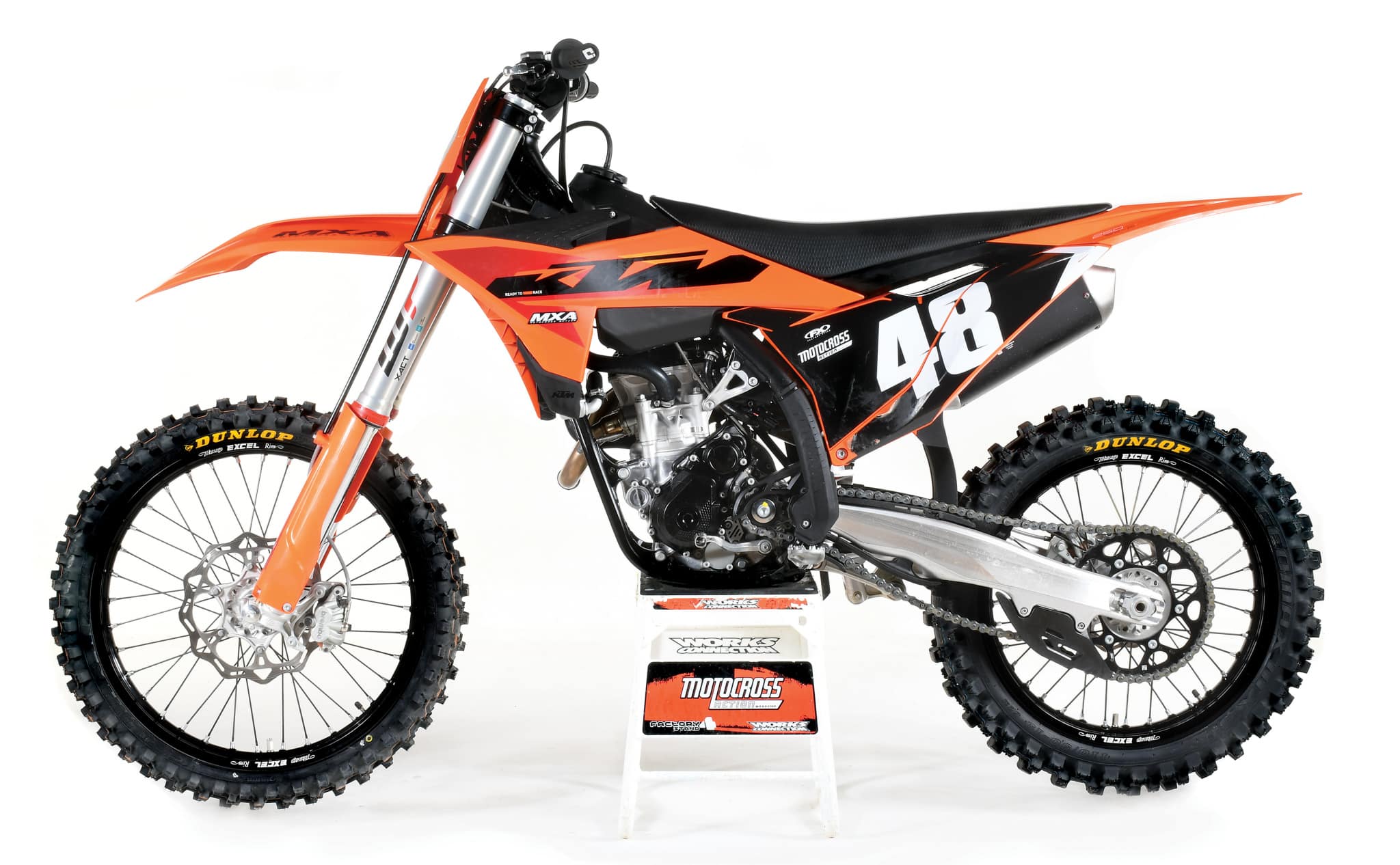 Great brakes, awesome clutch, perfectly linear high-rpm engine, and the best airbox design in the sport make the 2025 KTM 250SXF a front runner.
Great brakes, awesome clutch, perfectly linear high-rpm engine, and the best airbox design in the sport make the 2025 KTM 250SXF a front runner.
Q: HOW DOES THE 2025 KTM 250SXF HANDLE?
A: The previously unpopular rigid frame and long 10-hour break-in period were mainly a problem on the KTM 450SXF, while the 250SXF wasn’t as affected as its big brother. But, if the 450SXF frame was getting updates for 2025 that the factory test riders felt were solid improvements, KTM would have been foolish not to make the same changes on the KTM 250SXF. And, it would go against the grain of KTM’s platform-sharing strategy in which every bike between the three brands shares as many parts as possible. Even though MXA didn’t think that the 250SXF needed a new frame as much as the 450, the 250SXF did get better with the updated chassis. The most noticeable improvement in the frame is most accentuated in harsh acceleration bumps. The ’23–’24 models would often deflect in harsh chop, while the 2025 bike soaks up that negative energy more readily. Overall, the KTM 250SXF has been a very easy bike for our test riders to adapt to. We set the sag at 105mm, the air pressure in the forks to 10.7 bar (155 psi) and we’re good to go. The 250SXF is a confidence-inspiring machine that’s well-balanced and offers great traction.
Our test riders have years of experience with setting up the WP XACT air forks and we like them; however, we have also raced with Dal Soggio’s Sphere FSR-48 complete spring forks, Ohlins RXF 48S forks, WP’s in-house 6500 coil-spring cartridge forks and, of course, Kayaba-equipped coil spring kits, and loved them as well. The coil-spring forks offer improved hand comfort, follow the ground better and save time at the track since we didn’t have to check the air pressure several times throughout the day. The kicker is that with proper setup, the WP XACT air forks can do some things that the spring cartridge kits can’t do and they come on the bike—no need to spend $2000 to $7000 on aftermarket forks.
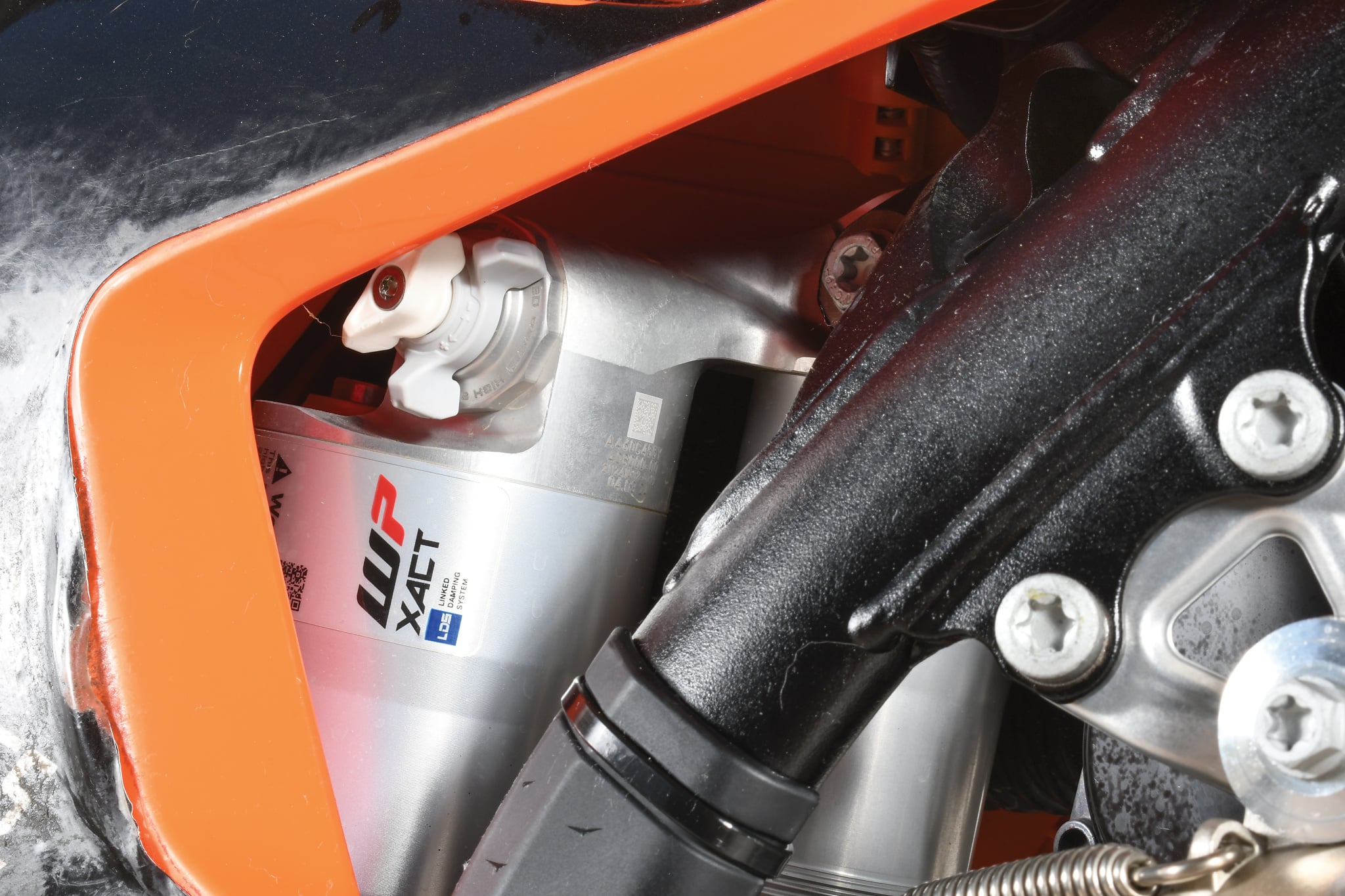 The high- and low-speed compression dials on the WP shock do not require tools to adjust, but KTM could have trimmed the side panel a touch to make using them easier.
The high- and low-speed compression dials on the WP shock do not require tools to adjust, but KTM could have trimmed the side panel a touch to make using them easier.
Q: HOW DOES THE 2025 KTM 250SXF RUN ON THE TRACK?
A: The KTM 250SXF engine is responsive and quick-revving, but it’s not as “hard-hitting” as the Yamaha YZ250F. The KTM 250SXF hits a peak of 45 horsepower at 13,000 rpm, while the Yamaha YZ250F peaks with 42.6 horsepower at 12,700 rpm. In terms of sheer torque, the KTM beats the Yamaha with 20.8 pound-feet of torque at 9400 rpm compared to Yamaha’s 19.6 pound-feet at 10,500 rpm. However, when riding the two bikes back to back, it’s easy to think the YZ250F is stronger. It’s much louder, which delivers a big sensory bonus, and it comes on stronger down low without requiring any extra clutch work.
The KTM, on the other hand, has an almost perfect linear powerband. It builds more and more power as it is revved, and it seems to rev forever. It soars up to 14,000 rpm and does its best work above 11,000 rpm. The power and torque are there, but it often requires nerves of steel to keep pouring the coal to get to it. If you put the vented airbox cover on, you will get more throttle response, and if you’re still not satisfied with the low-end torque, adding a tooth to the rear sprocket gives you even more grunt.
As for mapping, KTM didn’t publicly announce any updates on their 2025 spec sheet, but they did improve traction control on the new 2025 models. Still, we rarely use the TC mode on the 250SXF. It’s only beneficial if you’re racing on wet, muddy or rock-hard tracks, or if you’re 130 pounds and looking for an easy way to tame the 250SXF power.
 This radiator cap is a hassle to live with. The KTM factory team runs the old-style cap.
This radiator cap is a hassle to live with. The KTM factory team runs the old-style cap.
Q: WHAT DID WE HATE?
The hate list:
(1) Start/stop buttons. We still press the map-switch button to turn the bike off. If you want to go back to the traditional-style on/off buttons, Nihilo Concepts and Ride Engineering both have kits that move the kill button to more accessible locations. place.
(2) Chain slack. The 2023-and-newer KTM models require 70mm of chain slack. It’s about four fingers under the chain at the back of the buffer pad. If it looks too loose, it’s just right.
(3) Radiator cap. The plastic radiator cap has been known to leak coolant, plus it’s hard to take on and off. Nihilo Concepts makes a removal tool that helps.
(4) Spokes. Check the spokes closest to the rear rim lock; if those spokes are loose, you need to tighten them all.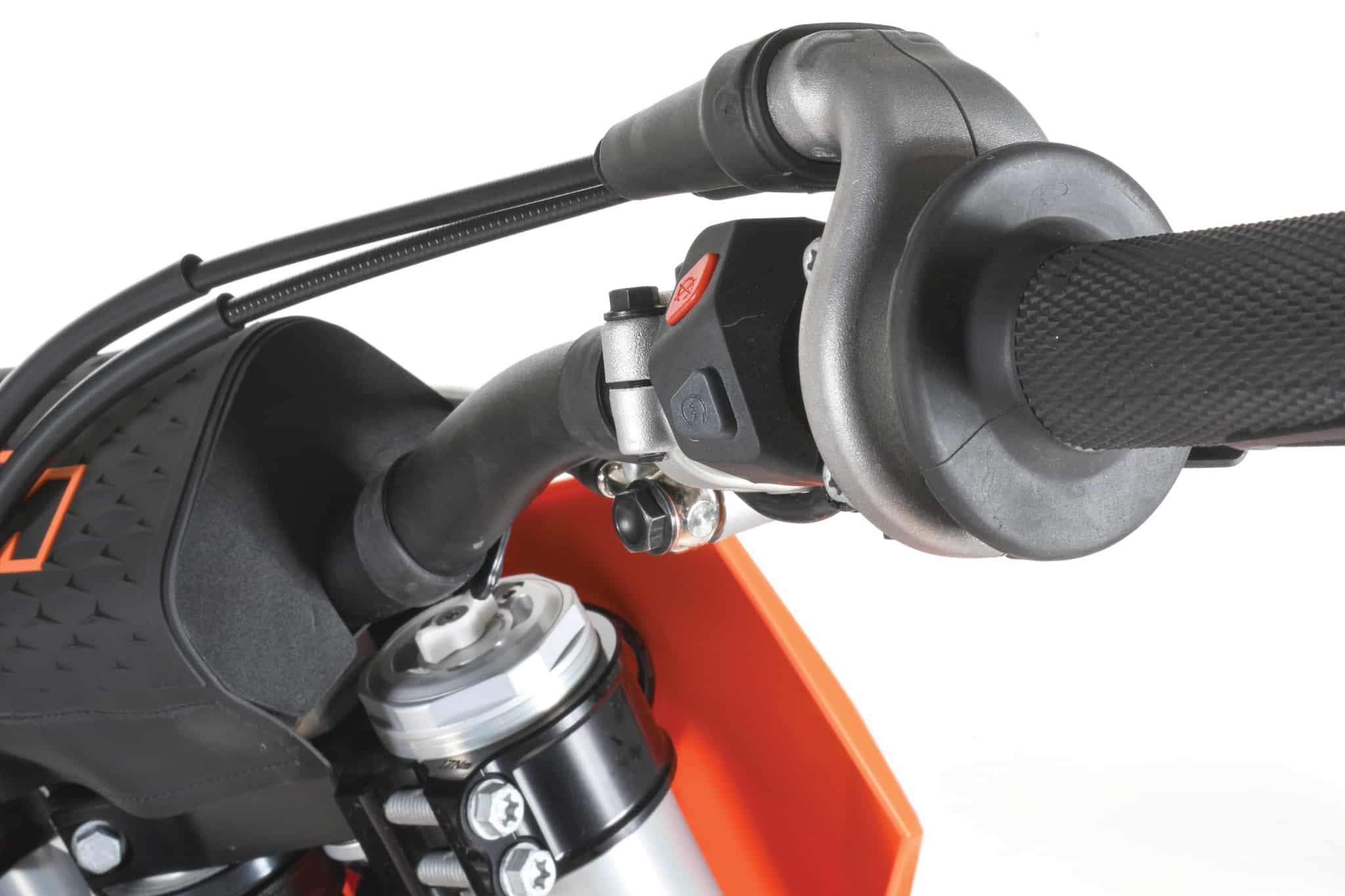 The red button is the kill switch. The black button is the electric starter.
The red button is the kill switch. The black button is the electric starter.
Q: WHAT DID WE LIKE?
A: The like list:
(1) CUO. The Factory Editions came with KTM’s new Connectivity Unit Offroad system, which allows you to adjust ECU mapping, and monitor engine parameters and lap times via LitPro technology. The GPS and transponder don’t come on the 2025 models, but they can be purchased ($249.99) and installed on the new bike, as well as the ’23 and ’24 models, too.
(2) Brakes. Brembo brakes are the best, and they inspire confidence on the downhills.
(3) Pedal. Starting in 2023, the tip on the rear brake pedal would bend and break on all of our test bikes. That’s been fixed for 2025.
(4) Shock collar. It’s more durable and easier to use than Showa and Kayaba collars.
(5) Vented airbox cover. We appreciate that KTM gives you options with their airbox covers.
(6) No-tools clickers. It’s nice to adjust everything (except the shock rebound clicker) by hand.
(7) Clutch. The Belleville washer spring and one-piece steel clutch basket/primary gear ensure the Austrians have the most durable clutch in the class.
Q: WHAT DO WE REALLY THINK?
A: The KTM 250SXF was already MXA’s 250 Shootout winner, and it only got better for 2025. The KTM 250SXF is durable, fast and nimble. If you love to rev a 250 four-stroke, you’ll fall in love with the 2025 KTM 250SXF. If you like to ride lower in the rpm, then you’ll appreciate an extra tooth on the rear sprocket.








Comments are closed.